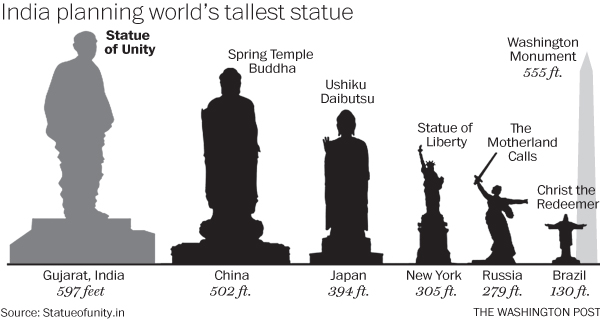Sunday Times 2
India’s new budget includes $34 m to build the world’s tallest statue
India has just presented its annual budget, which contains measures that seek to encourage growth and limit the deficit.
But one detail in the budget has struck many as incongruous with that plan: The equivalent of about $34 million (2 billion rupees) has been set aside to help build a statue. That’s certainly not chump change. And, amazingly, that may not be enough: Scroll India reports that the proposed budget for the statue is actually about $415 million.
What kind of statue can you build with that sort of money? Well, if everything goes to plan, you get the grandest statue in the world, standing almost 600 feet tall, with a museum, research center and even an underwater aquarium. Designed as a tribute to Sardar (Chief) Vallabhbhai Patel, one of the founding fathers of modern India, the project has been dubbed the “Statue of Unity” and a chance to “immortalize [India's] history.”
It may not be so simple, of course.
Plans for the Statue of Unity first emerged in 2010, when Narendra Modi, who was then chief minister of Gujarat state and is now India’s prime minister, announced the construction on an island opposite the Narmada Dam. It will be almost twice as tall as the Statue of Liberty and five times as tall as the Christ the Redeemer statue in Rio de Janeiro, Modi said at the time, later explaining that “the taller the statue will be, the more India will be known at the global stage.”
Patel was undoubtedly an important figure for India. The Gujarat native was a key leader during the country’s path to independence and helped to unify the princely states that eventually created India. Patel’s reputation as tough gave him an envious nickname, the “Iron Man of India,” and the proposed statue hopes to reflect this: Modi has asked poor residents of Gujarat to help collect scrap metal for the project. It is hoped that about 5,000 tons of iron can be collected for the project (unfortunately, much of the metal collected was found to be of poor quality and will not be used).
The inclusion of the public is one key aspect of the statue. Modi has attempted a huge grassroots outreach for the project, and its funding, a type of public-private partnership, called for a relatively low state investment that would be bolstered by private investment and public donations. However, even if 2 billion rupees perhaps seemed fairly modest at the time, few expected India’s central government to pay for the statue, and many in India feel that the money could be better spent: As the Associated Press notes, the budget allocated more money for the statue than for women’s safety programmes (1.5 billion rupees/$25 million) or the education of young girls (1 billion rupees/$16.5 million).
Some feel that the Statue of Unity is a personal project for Modi and the party he leads, the Hindu nationalist Bharatiya Janata Party.
While Patel was a leader in the Indian National Congress, many Indians feel that Congress neglected his legacy, focusing instead on the more accepted Nehru-Gandhi pantheon. BJP, Congress’s main rival, has gradually come to see him as a Hindu nationalist and accept him into their fold. Some might argue that this is a cynical project — a chance for the party to link itself with India’s independence movement or for Modi to set himself up as the next “Iron Man of India” — but many in India feel that Patel never got the recognition he deserved and that the statue is a way to honour him. “Every Indian regrets Sardar Patel did not become the first prime minister,” Modi said at a public event last year, in a jab at his Nehru-Gandhi dynasty rivals. “Had he been the first prime minister, the country’s fate and face would have been completely different.”
Statue-building is all about creating something that lasts for a long time, of course, and in centuries to come, the back story to the Patel statue (if it’s ever built) could be forgotten. Few people look at Rio’s Christ the Redeemer statue today and wonder whether its cost was worth it, I’d wager. But that doesn’t mean it isn’t without significant risk. For every Christ the Redeemer or Statue of Liberty, there are other examples of statues now seen as a colossal folly: Senegal’s $27 million Monument to African Renaissance springs to mind, for example.
Sadly, the Statue of Unity may not hold its title as the tallest statue in the world for long: The Indian state of Maharashtra plans to build a statue of the Hindu king Shivaji just outside Mumbai. If completed, it would be more than 620 feet tall.
Courtesy Washington Post

